Speech Competition in the Deposit Market

Malcolm Edey
Assistant Governor (Financial System)
Australian
Retail Deposits Conference 2010
Sydney –
- Audio 11.34MB
Introduction
The theme for this session is Pricing and Competition in the Deposit Market. It's a highly topical subject, because we have been seeing some very strong competition in this area in the recent period. To give one summary indicator: the average interest rate banks have been offering on their term-deposit ‘specials’ recently have been around 6 per cent, or about 100 basis points above the bill rate. A few years ago they were typically about 50 points below the bill rate – so there's been a price movement, in relative terms, of around 150 basis points.
That's a significant shift although, to keep it in perspective, we have to remember that this is not the whole market – it's just the part where competition has been most intense. Other rates are not as high. Nonetheless, across the board, spreads between deposit rates and wholesale rates have generally shifted in the same direction over the past couple of years.
Obviously this is good news for depositors. It means that, if you have funds to invest, and you're prepared to shop around, now is a very good time to find a favourable rate. Of course, from the point of view of deposit-takers[1] and the people they lend to, it mightn't seem particularly good news, because this is one of the factors that have been adding to the relative cost of funds, and therefore adding to the cost of lending.
I've been asked to talk today about what's driving this competition in the deposit market, and how it might develop from here. I'm going to stick to that brief, but I also want to place it in a broader context by looking at how competition has evolved over a longer period.
Evolution of Competition in the Post-deregulation Period
I'll take as a starting point a snapshot of the aggregate balance sheet of the banking system in 1980 – just before the main sweep of financial deregulation got under way (Table 1). Banks' balance sheets back then looked rather different from the way they do now. Roughly speaking, the liabilities side of the balance sheet consisted of close to 90 per cent deposits. On the asset side, loans were around 60 per cent of the total, and much of the rest consisted of government securities, which were held under the ‘captive market’ arrangements that were then in place.
| Assets | Per cent | Liabilities (excluding equity) | Per cent |
|---|---|---|---|
| Notes and Coins(a) | 2 | Deposits(e) | 87 |
| Public Sector Securities | 24 | Other | 13 |
| Loans(b) | 60 | ||
|
Housing(c)
|
22 | ||
|
Other
|
38 | ||
| Fixed Assets | 2 | ||
| Other(d) | 13 | ||
| Total | 100 | Total | 100 |
|
(a) Includes deposits with the Reserve Bank other than Statutory Reserve Deposits Source: RBA |
|||
In simplified terms, we can think of the banks' core business in that environment as being a mix of three main elements – namely, deposit-taking, lending, and providing transactional services. Banks' net interest margins were quite a bit wider than they are now. That was partly because their (non-interest) costs were higher. But in a deeper sense, it's also a reflection of the way competition has evolved in the meantime.
In the regulated environment, banks generally faced a situation of excess demand for their loans. As a result, competition within the banking sector was not very strong, and banks faced relatively weak pressure to contain costs.
These conditions affected not just the intensity of competition, but also its focal point. In the regulated environment, competition within banking tended to take place at the whole-of-bank level, rather than at the level of the individual product. There was no point competing to offer lower lending rates when the market was in structural excess demand. Instead, the banks competed to offer their full mix of services on terms that would be attractive as a package.
Typically the pricing structure that this type of competition generated involved significant elements of cross-subsidy. In particular, the net interest margin tended to cross-subsidise transaction services and other activities (such as the maintenance of branch networks) to a much greater extent than is the case today. This is the business model that used to be referred to, only half jokingly, as 3-6-3 banking – borrow at 3 per cent, lend at 6 per cent and be on the golf course by 3 o'clock – although even then the joke was probably well past its use-by date.
Obviously, a great deal has changed in the banking industry since then. Banks have become much more diversified, both in their funding sources and in the range of businesses they engage in.
But for the purpose of today's subject, the thing I particularly want to focus on is the change in the way they compete. Post-deregulation, competition has been both more intense, and increasingly directed at the level of the individual product. That's been true of both the competition between banks, and the competition provided by specialist institutions that targeted the banks' most profitable product lines.
One early example of that, on the deposit side, was the introduction of cash management trusts, which came in as providers of what were effectively stand-alone deposit-taking services. The effect was to put upward pressure on deposit interest rates relative to wholesale rates – in other words, to give depositors a better deal. Specialist mortgage originators later did a similar thing on the lending side. Over time, these sorts of developments had the side-effect of reducing the amount of net interest margin available for banks to cross-subsidise their other activities. In addition, technological improvements like internet banking have contributed to the intensity of product-level competition, by making it easier for customers to shop around on a product-by-product basis.
The results of all this can be seen in some summary indicators of the banking sectors' aggregate performance.
Let's start by looking at the relativities between deposit and loan rates and interest rates in the wholesale market (Graph 1). For much of the 1980s, the 90-day bill rate was actually higher than the average rate that banks charged on loans, a result of regulations that held lending rates much lower than they would otherwise have been.[2] Of course, that didn't mean that borrowers were on average getting a favourable deal. It just meant they were being rationed for funds and may have had to go outside the regulated sector where rates were much higher.
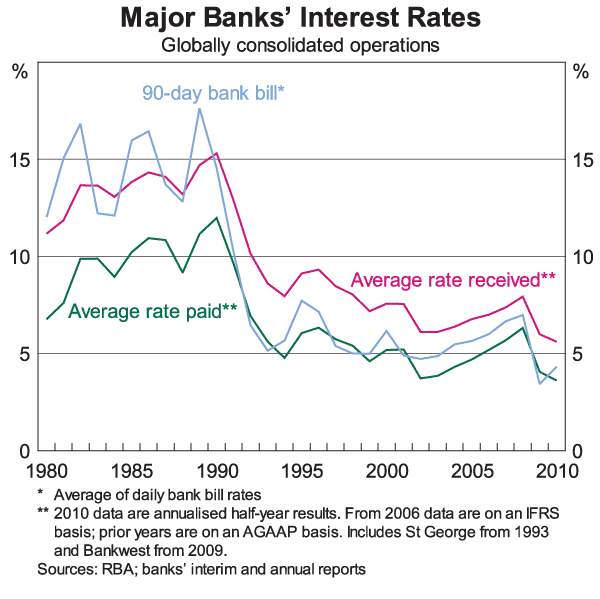
In the post-deregulation environment, from the 1990s onwards, the whole interest rate structure was much lower because of the fall in inflation that occurred at that time, but wholesale rates fell significantly further than both deposit and lending rates. This restored the structure to a more logical configuration where average lending rates were usually above the wholesale rate and deposit rates below it.
An important driver of the fall in banks' intermediation margins on the liabilities side has been the declining share of deposits bearing either zero or very low interest (Graph 2). That was partly a regulatory effect, since before 1984 banks were prohibited from paying interest on current accounts. But it was also a consequence of stronger competition. In 1980, around a third of bank deposits were either in interest-free current accounts or in low-interest passbook accounts. Twenty years later, that proportion was down to around 5 per cent. Not only did this proportion decline, but the relative benefit to banks from any given amount of low-interest deposits has fallen substantially, as the overall interest-rate structure has come down.
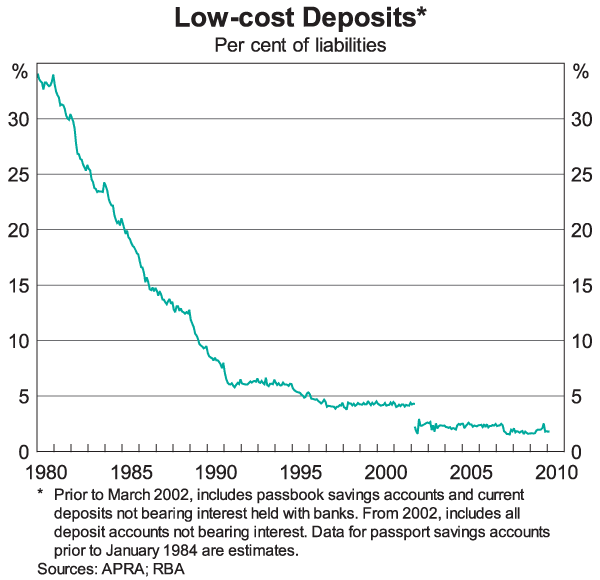
Another important development on the liabilities side, which I alluded to earlier, was that an increasing proportion of banks' funding was coming from wholesale sources. That was a partly a consequence of the growth of the superannuation system as a recipient of household funds, some of which were then channelled into bank securities; it was also partly a result of the banks' diversification into offshore funding sources.
We see, then, that a combination of structural factors, regulatory changes and increased competition has been working to narrow average margins on the liabilities side for quite some time. A similar thing happened on the lending side: after the initial reconfiguration of interest rates that occurred in the early 1990s, competition over the subsequent decade put substantial downward pressure on most lending rates relative to wholesale funding costs.
The result of all this is that the major banks' net interest margins in the period since deregulation have been trending downwards (Graph 3). They roughly halved, from an average of around 4½ per cent in 1980 to a bit over 2 per cent in the latest period. Notwithstanding its most recent uptick, the average margin now is well below where it was a few years ago.
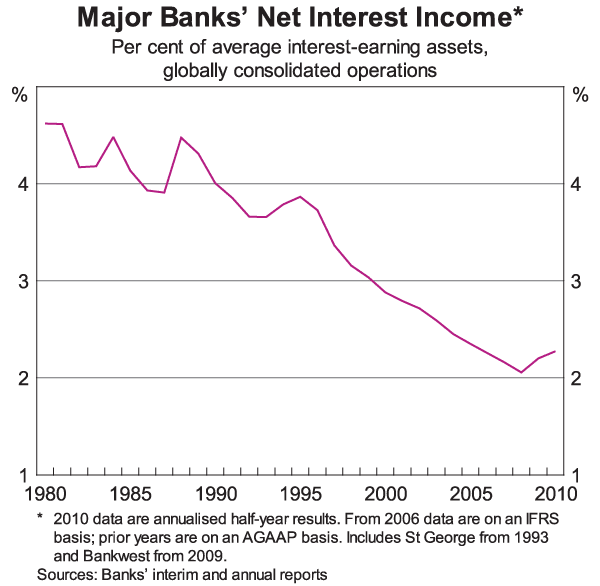
To complete the story, the downward trend in net interest margins hasn't resulted in any structural decline in banks' overall profitability (Graph 4). In broad terms it has been offset by two factors – namely, reduced non-interest costs, and increased non-interest income as banks diversified their business models and reduced cross-subsidies. The net effect is that banks' combined income from all sources has been declining in relation to assets, but this has been broadly matched by a downward trend in the cost-to-assets ratio.
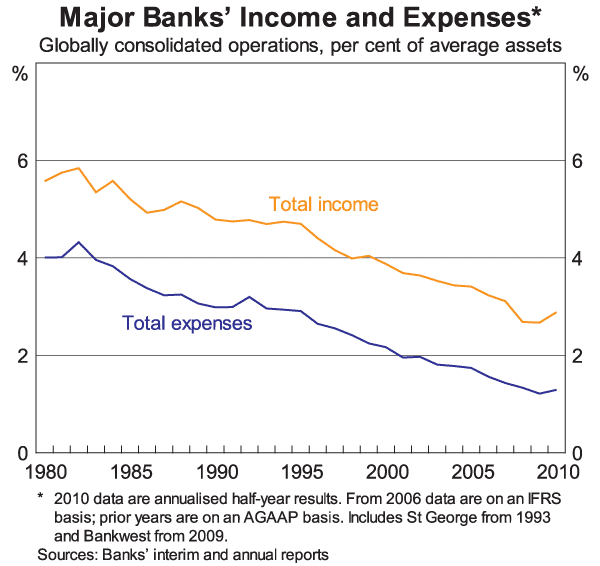
Probably much of this is familiar territory. My reason for going through it is to make the point that a trend towards increased competition in the deposit market, and an increased relative cost of deposits, is not something new. It has been an ongoing consequence of the way market forces have evolved in a deregulated environment.
Effects of the Crisis on the Deposit Market
Having made that point, it's also clear that the trend has been amplified by factors flowing specifically from the financial crisis. Let me turn to that part of the story now.
For some time, banks have tended to operate with a two-tier pricing structure on their term deposits, offering significantly higher-than-average rates at certain points on the maturity spectrum. Often these are at non-standard terms like four or seven months. These ‘specials’ have been the part of the market where banks competed most vigorously for price-sensitive customers.
The average rates on these specials are shown in the accompanying chart (Graph 5). In the years just prior to the crisis, the pricing of these term-deposit specials was fairly stable. They were typically priced at about 50 basis points below the bill rate. As I noted at the outset, that margin has now shifted to around 100 points above.
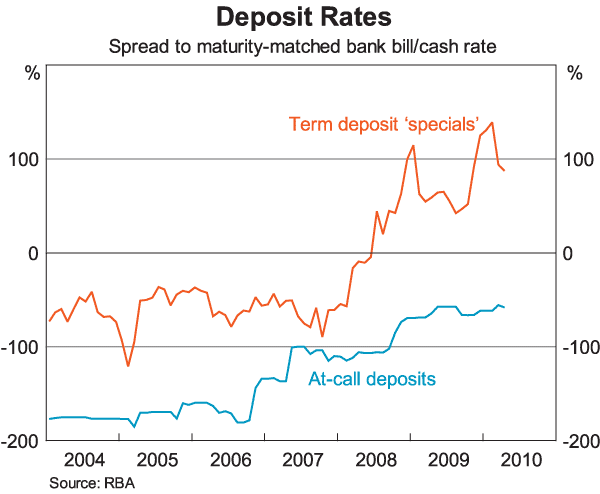
Another indication of more intense competition is that institutions have become more active in offering special rates at terms of longer than a year, and often out to as much as five years. They have also begun to offer higher rates in other parts of the market. Rates on ‘non-special’ term deposits have tended to move up closer to the specials, and margins on at-call deposits have moved in the same direction, though by a lesser amount.
So, clearly the intensity of competition has stepped up.
This has been a consequence of two factors associated broadly with the crisis and with the post-crisis environment.
First, the crisis has focused the attention of investors, regulators, rating agencies and, not least, the banks themselves, on the need for stable sources of funding. What constitutes stable funding is, of course, a good question. There is some tendency for analysis in this area to be overly simplistic, and in particular to assume that deposits are unambiguously more sticky than various forms of wholesale funding. That might not always be the case. Within short-term wholesale funding, for example, holdings of bank paper by domestic super funds are actually likely to be quite stable. Conversely, those types of deposits designed specifically to appeal to price-sensitive customers will be less stable than others. So in analysing funding stability, it is important to focus on the specific characteristics of each instrument, and not just to rely on broad summary measures like aggregate deposit ratios.
That said, markets have clearly been taking a general view that banks should source more of their funding from deposits rather than from short-term wholesale liabilities, and there is no doubt that this has been a factor in market pricing in the post-crisis environment. It's also clear that prospective regulatory developments are going to put more emphasis on stable deposit funding, although there are many details of this still to be worked out.
A second factor is that the crisis made non-deposit sources of funding more expensive, or in some cases more difficult for lending institutions to obtain, than was previously the case. In this environment, it is to be expected that deposit rates would be bid up. One element of the change in funding conditions was the drying up of the RMBS market early in the crisis period. That was a factor that disproportionately affected the smaller lenders and induced them to compete more vigorously for deposits as an alternative source of funding.
These factors are of course not unique to Australia. There are, however, some arguments that it may be more difficult for banks to attract deposit funding in Australia than elsewhere, because a structurally higher share of their funding comes from non-deposit sources – particularly from international markets and from domestic super funds. These funding patterns may be hard to change quickly, although we certainly shouldn't think of them as being immutable.
How far these Australia-specific factors might be adding to competitive pressure on deposit markets is hard to judge. But it's notable that significant shifts in deposit margins have been occurring in a number of other economies besides Australia (Graph 6). Although strictly comparable data are hard to come by, term deposit margins in the UK look to have risen by more than those in Australia. In the euro area, average margins rose initially by a similar amount to those in the UK, though they have since retraced some of that. So, on the face of it, it seems likely that a good deal of the recent pressure on deposit rates has reflected common international forces, not just conditions specific to Australia.
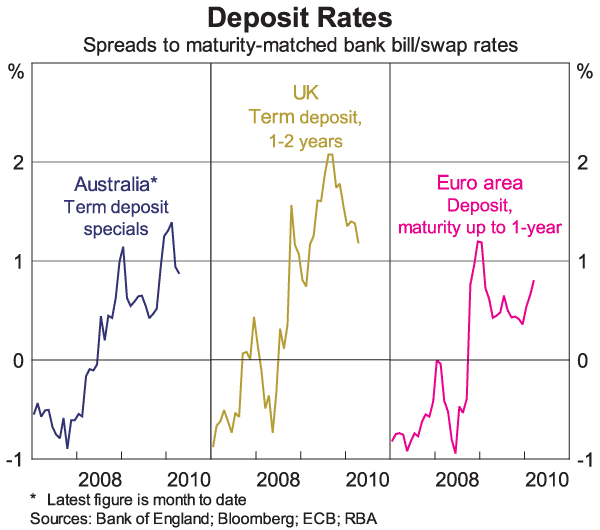
Assessment and Outlook
Let me conclude with a few more general remarks about what all this means and how things might develop from here.
My first remark is that we shouldn't talk as though competition in this market is a bad thing in itself. The point of financial deregulation was to deliver efficiency gains through increased competition. Among other things, that should mean a better deal for banks' customers. The particular customer we've been talking about today is the depositor, someone who is often neglected in these sorts of discussions. As I said at the outset, if you're a depositor who is prepared to shop around, now is a very good time to find favourable rates.
It's also important to put these things in a longer-term context. The tendency for competition to put downward pressure on banks' net interest margins is not new – it's been going on for a couple of decades, to the benefit of both borrowers and depositors.
Having said all that, there's a legitimate question as to how far the most recent step-up in competition for deposits will prove to be sustainable. There do seem to have been some instances of anomalously high deposit rates being offered on occasion. It seems likely that, over time, banks and other deposit-takers will get better at managing these more competitive conditions and avoiding paying rates that are unnecessarily high relative to the market.
There are other reasons to think that the factors giving rise to the current wave of competitive pressure might prove to be partly transitory. In particular, conditions in alternative funding markets have been improving. A further recovery in securitisation markets, for example, would help lenders to diversify their funding sources and probably help to take some pressure off the deposit market. Similarly, any further narrowing of risk spreads in other wholesale funding markets would work in the same direction. Possibly reflecting some of these factors, there does seem to have been some easing in deposit margins recently.
On the other hand, we should expect the increased emphasis on stable funding sources to continue. It is also possible that the recent wave of competition has itself helped to make depositors more price-sensitive. With the availability of special rates being more widely advertised, households may be learning to be more active, and more sophisticated, in seeking out the most favourable rates. If so, then we would expect this to have an ongoing impact on the dynamics of the market.
In a nutshell then, a good deal of what is happening in deposit markets is not new, but is actually a continuation of existing trends. Some of what is new might prove to be temporary, but some of it is likely to persist. To me, that sounds like an environment where competitive pressure in the deposit market is going to remain strong, even if some of the recent intensity has been somewhat overdone.
Endnotes
In this talk I focus mainly on banks, though much of what I have to say applies to the deposit-taking sector in general. [1]
Interest rate regulations on deposits and loans were progressively removed during the 1980s. The last major control to be removed was the ceiling on housing loan interest rates. This was removed for new loans in 1986, but since existing loans were grandfathered, it continued to affect the average rate on loans outstanding through the remainder of the decade. [2]